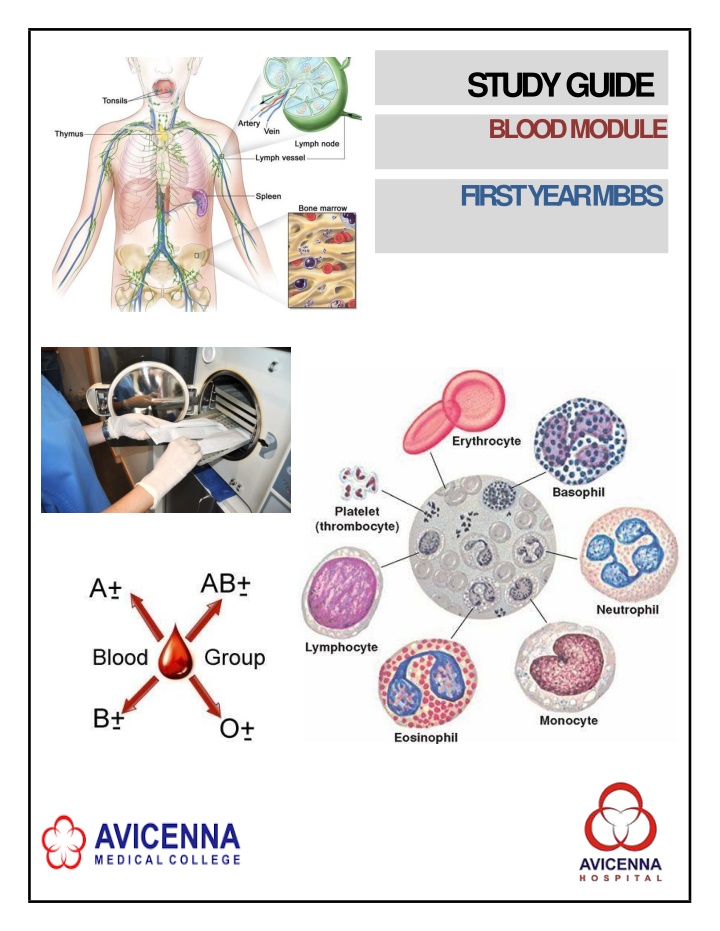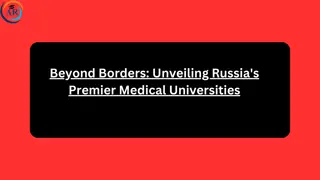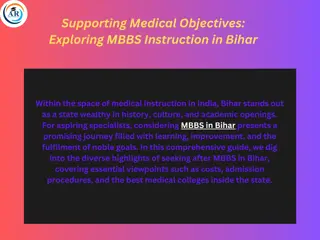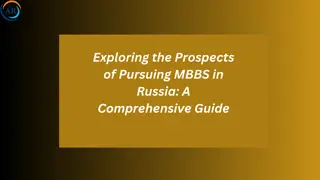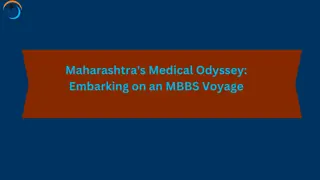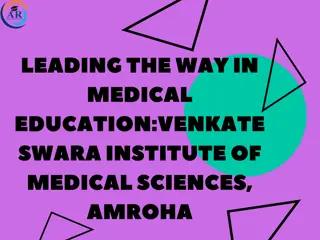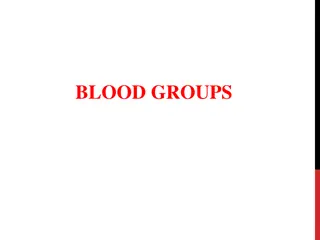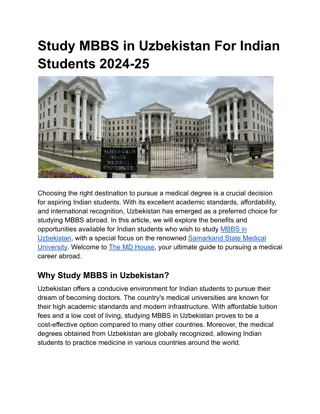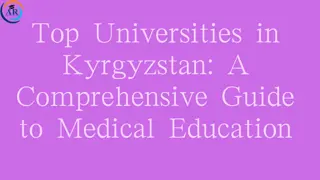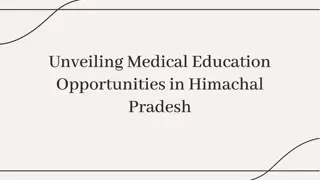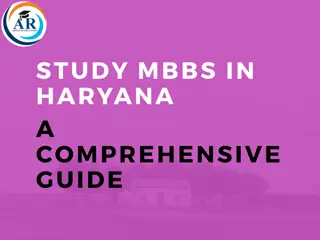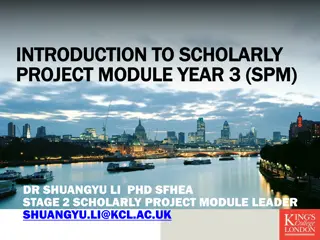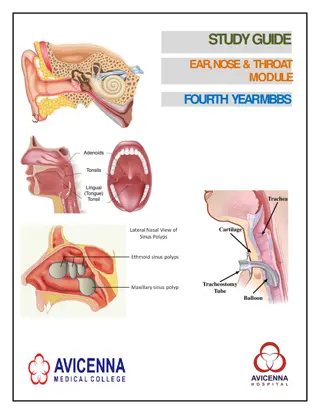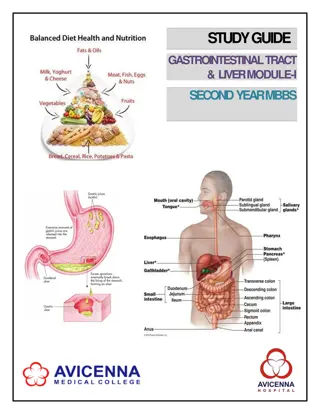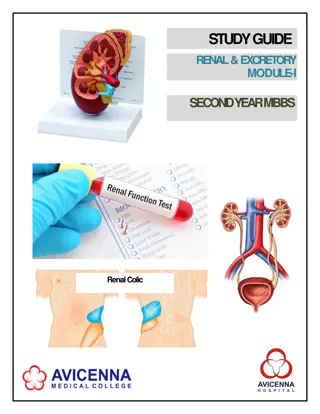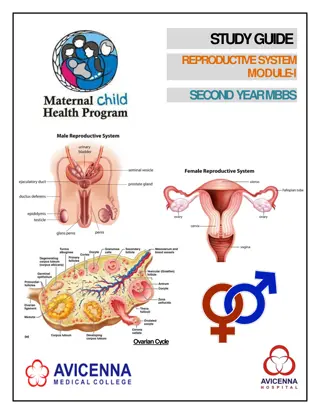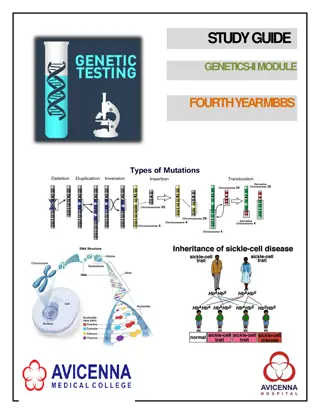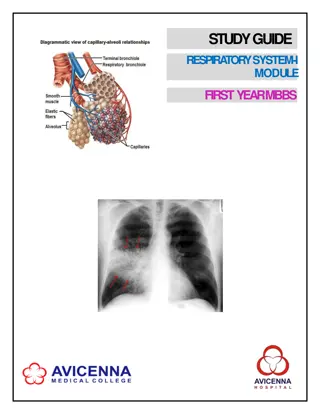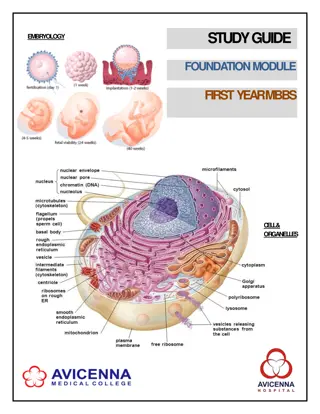Comprehensive Study Guide for First Year MBBS Blood Module at Avicenna Medical College
This study guide provides a detailed overview of the first-year MBBS Blood Module at Avicenna Medical College, including learning methodologies, objectives, assessment methods, and regulations. Organized by a dedicated committee, the guide offers valuable resources, curriculum frameworks, and integrated teaching approaches to enhance students' understanding of basic sciences in relation to clinical practice.
Download Presentation

Please find below an Image/Link to download the presentation.
The content on the website is provided AS IS for your information and personal use only. It may not be sold, licensed, or shared on other websites without obtaining consent from the author.If you encounter any issues during the download, it is possible that the publisher has removed the file from their server.
You are allowed to download the files provided on this website for personal or commercial use, subject to the condition that they are used lawfully. All files are the property of their respective owners.
The content on the website is provided AS IS for your information and personal use only. It may not be sold, licensed, or shared on other websites without obtaining consent from the author.
E N D
Presentation Transcript
STUDYGUIDE BLOODMODULE FIRST YEARMBBS
1ST YEAR MBBS, BLOODMODULE AVICENNA MEDICAL COLLEGE STUDY GUIDE FOR BLOODMODULE PageNo S.No CONTENTS 3 4 5 7 7 8 14 16 18 19 1 2 3 4 Overview Introduction to StudyGuide LearningMethodologies Module2:BLOOD Introduction Objectives andstrategies LearningResources AssessmentMethods Modular Examination Rules And Regulations(AVMC) Schedule 4.1 4.2 5 6 7 8 Page|2
1ST YEAR MBBS, BLOODMODULE AVICENNA MEDICAL COLLEGE Year:One Duration: 4 weeks Timetable hours: Lectures, Case-Based Learning (CBL), Team based Learning (TBL), Self-Study, Practical, Skills, Demonstrations, Field Visits, Visit to Wards& Laboratory MODULE INTEGRA TEDCOMMITTEE MODULECOORDINATOR: CO-COORDINATORS: Professor Dr. Zubair Ahmad(Biochemistry) Professor Dr. Rubina Hafeez (Pathology) Professor Dr.Rehana Shahid(Anatomy) DEPARTMENTS & RESOURCE PERSONS FACILITA TINGLEARNING BASIC HEALTHSCIENCES CLINICAL AND ANCILLARYDEPARTMENTS FAMILYMEDICINE Professor Dr. Muhammad Luqman ANATOMY Professor Dr.Rehana Shahid BIOCHEMISTRY Professor Dr. Zubair Ahmad MEDICALEDUCATION Professor Dr. Waheed Ahmad COMMUNITYMEDICINE Professor Dr. Rana Muhammad Akhtar Khan INTERNALMEDICINE Dr. Muhammad Usman Amir PATHOLOGY HEMATOOGY Dr. Syeda Ijlal Zehra Zaidi Professor Dr. Rubina Hafeez PHYSIOLOGY Professor Dr. Binyamin Ahmad PHARMACOLOGY Professor Dr. Rana Tariq Mehmood AVMCMANAGEMENT Professor Dr. Gulfreen Waheed, PrincipalAVMC Brig.Dr. Gul e Rana , Director AVMC Dr. Sadia Awan Dr. Muhammad Muzzammil Sadiq Dr. Usama Bin Ishtiaq STUDY GUIDE COMPILEDBY: Department of Health CareEducation Page|3
1ST YEAR MBBS, BLOODMODULE AVICENNA MEDICAL COLLEGE INTRODUCTION WHAT IS A STUDYGUIDE? It is an aidto: Informstudentshow student learningprogramof thesemester-wisemodulehasbeenorganized Help students organize and manage theirstudies throughout the module Guide students on assessment methods, rules andregulations THE STUDY GUIDE: Communicates information on organization and management of the module. Thiswill helpthe studentto contactthe rightpersonin caseofanydifficulty. Definestheobjectiveswhich are expectedto beachieved at the endof themodule. Identifies the learning strategies such as lectures, small group teachings, clinical skills, demonstration, tutorial and casebased learning that will be implemented to achieve the module objectives. Provides a list of learning resources such as books, computer assisted learning programs, web- links,journals,for studentsto consultinorderto maximize their learning. Highlights informationonthe contributionof continuousandsemesterexaminationsonthe student s overallperformance. Includesinformationon the assessmentmethodsthatwill beheld to determine everystudent s Achievement of objectives. Focuses on information pertaining toexamination policy, rules and regulations. CURRICULUMFRAMEWORK Students will experience integratedcurriculum. INTEGRATED CURRICULUM comprises of system-based modules such as foundation and blood which links basic science knowledge to clinical problems. Integrated teaching means that subjects are presented as a meaningful whole. Students will be able to have better understanding of basic sciences when they repeatedly learn in relation toclinical examples. Case-based discussions, computer-based assignments, early exposure to clinics, wards, and skills acquisition in skills lab and physiotherapy department are characteristics of integrated teachingprogram. Page|4
1ST YEAR MBBS, BLOODMODULE AVICENNA MEDICAL COLLEGE LEARNINGMETHODOLOGIES Thefollowing teaching/learningmethodsareusedto promotebetterunderstanding: InteractiveLectures Hospital/Clinicvisits Small Group Discussion Case-BasedLearning Practicals Skills session E-Learning Self-DirectedStudy INTERACTIVELECTURES In large group, the lecturer introduces atopic or common clinical conditions and explains the under lying phenomena through questions, pictures, videos of patients interviews, exercises, etc. Students are actively involved in the learningprocess. HOSPITAL VISITS: In small groups, students observe patients with signs and symptoms in hospital or clinical settings. This helps students to relate knowledge of basic and clinical sciences of the relevant module. Page|5
1ST YEAR MBBS, BLOODMODULE AVICENNA MEDICAL COLLEGE SMALL GROUP DISCUSSION (SGD): This format helps students to clarify concepts acquire skills or attitudes. Sessions are structured with the help of specific exercises such as patient case, interviews or discussion topics. Students exchange opinions and apply knowledge gained from lectures, tutorials and self-study. The facilitator role is to ask probing questions, summarize, or re phrase to help clarify concepts. TEAM-BASED LEARNING: A small group discussion format where learning is focused around a series of questions based on a clinical scenario. Students discuss and answer the questions applying relevant knowledge gainedin clinical andbasichealth sciencesduring themodule. a) Preparation before class: Students must complete preparatory materials before a class or the start of the module. Materials maybe text, visual or other, and set at alevel that is appropriate to the studentsandthecourse. b) In-class Readiness Assurance Testing: Students complete an individual readiness assurance test (IRAT), consisting of 5 to 20 multiple choice questions. After submitting their individual answers, and they take the same test, the team RAT (TRAT), with their team. All members of each team sharethe sameTRATscore,andboth IRATandTRATscorescount toward the students grades. c) Instructor Feedback: The instructor reviews material from the RAT that seems to be difficult for students. d) In-classapplicationfocusedexercise:Theremainder of the session is taken up with exercises that help students learn how to apply and extend the knowledge that they have pre-learned and tested. Teams are given an appropriate problem or challenge, and must arrive at a consensus to choose a best solution out of options provided. Teamsthen display their answer choice, andthe educator facilitates a classroom discussion between teams to explore the topic and the possible answersto theproblem. PRACTICAL: Basic science practicals related to anatomy, biochemistry, pathology, pharmacology and physiologyarescheduled for studentlearning. SKILLSSESSION:Skillsrelevant to respectivemodule areobservedandpracticed where applicablein skills laboratory or DepartmentofPhysiotherapy. SELFDIRECTEDSTUDY:Students assume responsibilities of their own learning through individual study, sharing and discussing with peers, seeking information from Learning Resource Center, teachers and resource persons within and outside the college. Students can utilize the time within the college scheduled hoursofself-study. E-LEARNING: E-Learning is a strategy by which learning occurs through the utilization of electronic media, typically the Internet. The basic aspects of medical professionalism and ethics will be addressed throughane-learningcourse. Page|6
1ST YEAR MBBS, BLOODMODULE A VICENNA MEDICA L COLLEGE SEMESTER 1 MODULE 2:BLOOD INTRODUCTION This module aims to provide the basic understanding of hematopoiesis and hemostasis at the molecularlevel.It will alsooutline the basicpathologicalprocessesin the developmentof cancers.It will deal with the basic pathophysiology and pharmacological aspects of infections and chemotherapeutic agents and integrate it withclinical sciences. The module will give the 1st year medical students, an opportunity to know the presentations and principles of management ofcommon hematological, immunological, inflammatory and neoplastic disorders. Overall, it will provide the students with the necessary factual knowledge and stimulate themto applythis intheinterpretationof thedisease. Page|7
1ST YEAR MBBS, BLOODMODULE AVICENNA MEDICAL COLLEGE COURSE OBJECTIVES ANDSTRA TEGIES At theendof themodulethestudentswill beable to: LEARNING STRATEGY TOPICS &OBJECTIVES FACULTY Lymphoid tissue & Immunesystem Name the components of immune system andlymphoid tissue Differentiate between central lymphoid organsand peripheral lymphoidorgans InteractiveLecture Interactive Lecture/Small GroupDiscussion Describe the structure of lymphnodes Describe the structure and histological appearanceof thymus InteractiveLecture Discuss the clinical anatomy of lymphoidorgans Definethestructureandlocationsof tonsils Small Group Discussion/Practical Describe histological features oftonsils Definethestructureandlocationsof spleen Describe the histological appearance ofspleen Practical/Skill Anatomy Enumerate lymphoid organs Briefly describe microscopic structure of lymphoidtissue Describe the structure of lymphnodes Explain the histological features of lymphnodes Describe the structure ofthymus Practical Explain the histological features ofThymus Describe the structure and locations oftonsils Identify the histological features oftonsils Describe the location and structure ofspleen Identify the histological features ofspleen Page|8
1ST YEAR MBBS, BLOODMODULE AVICENNA MEDICAL COLLEGE Defineimmunoglobulins Practical/Skill Classifyimmunoglobulins Describe the chemistry and structure ofimmunoglobulins InteractiveLecture Biochemistry Discuss the use and applications ofElectrophoresis Practical Discuss the use and application ofELISA Define immunity & itstypes Explain innate immunity withexamples Describe cell mediated immunity &its attributes Discuss the role of passive immunity againstinfection Interactive Lectures/Small GroupDiscussion .Explain the development and processing of B lymphocytes Discuss the role of B lymphocyte clone and memorycells Physiology Describe the mechanism of action ofantibodies Describe the Classical & Alternate pathwaysof complement cascade & itsattributes Perform LeucocytesCount Practical Cells Interactive Lectures/Small GroupDiscussion Definehematopoiesis List the sites and source of hematopoiesis beforeand afterbirth Explain the structure and types ofhemoglobin Explain the Allosteric Properties ofHemoglobin Describe the synthesis ofhemoglobin and its abnormalities Describe the biochemical abnormalitiesin hemoglobinopathies Classify plasmaproteins Differentiate between plasma and serum based ontheir compositions Summarize the clinical features of diseases dueto abnormalities of plasmaprotein Anatomy Interactive Lecture/Small GroupDiscussion Biochemistry Enumeratethefunctionsof the cellularcomponentsof blood State the normal values of RBCs, WBCs & platelets Define hematocrit, normal values& factorsaffecting hematocrit Discuss the different stages of RBCsformation List factors necessary forerythropoiesis Discuss the significance of Reticulocytecount Interactive Lectures/Small GroupDiscussion Physiology Page|9
1ST YEAR MBBS, BLOODMODULE AVICENNA MEDICAL COLLEGE Discuss the role ofErythropoietin Describe the process of leukocytegenesis List various types of granulocytes and agranulocytes,their functions & normalvalues Explain the significance of Reticuloendothelial system in body defensemechanism Interactive Lectures/Small GroupDiscussion List various macrophages in different tissues ofbody Physiology Defineinflammation Discuss the signs ofinflammation Discussthe walling off effectof inflammation Explain the neutrophil ¯ophage response during inflammation Discuss the lines of defense duringinflammation List types ofinflammation Describe the process ofinflammation Listthe typesof lymphocytes and theirsiteof origin InteractiveLecture Pathology Interactive Lectures/Small GroupDiscussion Discuss the functions of T and Blymphocytes Enumerate types of T lymphocytes & theirfunctions Physiology Demonstrate peripheral bloodsmear Practical Determine Erythrocyte SedimentationRate Describe thestepsof how to collect andstoreblood specimen for biochemicalanalysis Practical Biochemistry Discuss the use and applications ofSpectrophotometer Discuss the use and applications of Flamephotometer Anemia Discuss Iron metabolism in thebody Describe abnormalities of ironmetabolism Interactive Lectures/Small GroupDiscussion Biochemistry Describe the functions and biochemical importanceof Vitamin B12 & folicacid Describe theeffectsof deficiencyof VitaminsB12and Folic acid (Pernicious and Megaloblasticanemias) Page|10
1ST YEAR MBBS, BLOODMODULE AVICENNA MEDICAL COLLEGE DefineAnemia Interactive Lectures/Small GroupDiscussion Describe the clinical features ofanemia FamilyMedicine Check for anemia on eachother Describe the morphological &etiological classification of anemia Discuss the significance of red cell indices andtheir normalvalues. Interactive Lectures/Small GroupDiscussion Physiology Discuss the etiology, microscopic picture and principlesof management of common hemolyticanemias Discuss the etiology& microscopic pictureof Megaloblastic and iron deficiencyanemia Differentiate between Megaloblastic & PerniciousAnemia based on microscopic picture and red cellindices. Describe the mechanism of action and uses ofhematinics Pharmacology Assess the anemia on the basis of history,examination andinvestigation Devise life course health education ofblood related communicable and non-communicablediseases Internal Medicine Community Medicine InteractiveLectures Polycythemia Define types ofpolycythemia InteractiveLecture Physiology Explaintheeffectsof polycythemiaonhumanbody Hemostasis & itsdisorders Describe biochemical functions of Vitamins K andits deficiency ClassifyEicosanoids Biochemistry Describe their Biochemical role in plateletaggregation Interactive Lectures/Small GroupDiscussion Describe the events inHemostasis Explainthemechanismof formationof platelet plug Physiology Describetherole of Prothrombinin blood coagulation and clot formation Page|11
1ST YEAR MBBS, BLOODMODULE AVICENNA MEDICAL COLLEGE Explain intrinsic and extrinsic pathway forcoagulation Enumerate the clottingfactors Describe therole of clottingfactorsin coagulation Explain the fibrinolytic mechanism and role ofplasmin in lysis of bloodclots Interactive Lecture/Small GroupDiscussion Discussthe role of fibrin& anti-thrombinIIIin anticoagulation Physiology Explain the following hemorrhagic and Thrombo-embolic conditions: I. Hemophilia II. Thrombocytopenia III. Disseminated IntravascularCoagulation Discuss the role of commonlyused anticoagulants Practical Performtestsof bleedingtimeandclottingtime Pharmacology List the use ofanticoagulants InteractiveLecture Describe the various clinical presentationsof thrombocytopenia Hematology Antioxidants Biochemistry InteractiveLecture Explaintherole of majorantioxidants intheplasma Blood groups & ABO Explain the ABO(classical) and Rh system of blood grouping & their inheritancepattern. Interactive Lectures/Small GroupDiscussion Define Agglutinogen, agglutinin &agglutination Physiology List various Rh antigens & Rh immuneresponse Name the transfusion reactions associatedwith mismatched bloodtransfusion Perform tests for A,B,O, & Rh bloodgrouping Practical Page|12
1ST YEAR MBBS, BLOODMODULE AVICENNA MEDICAL COLLEGE Allergy andhypersensitivity Discuss the following types of hypersensitivity andallergic reactions: i) Urticaria ii) Anaphylaxis iii) Hayfever Discuss the role of Ig E inImmunity Interactive Lectures/Small GroupDiscussion Physiology Enzymes Explain the clinical application ofenzymes InteractiveLecture Biochemistry Perform the Salivary Amylase test (qualitative) todetect factors affecting enzymeactivity Practical Page|13
1ST YEAR MBBS, BLOODMODULE AVICENNA MEDICAL COLLEGE LEARNINGRESOURCES SUBJECT RESOURCES A. GROSSANATOMY 1. K.L. Moore, Clinically OrientedAnatomy 2. Neuro Anatomy by RichardSnell 3.https://www.kenhub.com/en/dashboard B. HISTOLOGY 1. B. Young J. W. Health Wheather s Functional Histology C. EMBRYOLOGY 1. KeithL. Moore.The DevelopingHuman 2. Langman s Medical Embryology ANATOMY A. TEXTBOOKS 1. Harper s IllustratedBiochemistry 2. Lehninger Principle of Biochemistry 3. Biochemistry byDevlin BIOCHEMISTRY A. TEXTBOOKS 1. Textbook Of Medical Physiology by Guyton AndHall 2. Ganong S Review of MedicalPhysiology 3. Human Physiology by LauraleeSherwood 4. Berne & LevyPhysiology 5. Best & Taylor Physiological Basis of MedicalPractice B. REFERENCEBOOKS 1. Guyton & Hall PhysiologicalReview 2. Essentials Of Medical Physiology byJaypee 3. Textbook Of Medical Physiology byInduKhurana 4. Short Textbook Of Physiology byMrthur 5. NMSPhysiology PHYSIOLOGY A. TEXTBOOKS 1. Robbins & Cotran, Pathologic Basis of Disease, 9thedition. 2. Rapid Review Pathology, 4th edition by Edward F. GoljanMD PATHOLOGY/MICROBIOLOGY 1. http://library.med.utah.edu/WebPath/webpath.html 2. http://www.pathologyatlas.ro/ A. TEXTBOOKS 1. Lippincot IllustratedPharmacology 2. Basic and Clinical Pharmacology by Katzung PHARMACOLOGY Page|14
1ST YEAR MBBS, BLOODMODULE AVICENNA MEDICAL COLLEGE OTHER LEARNINGRESOURCES Hands-on Activities/PracticalStudents will be involved in Practical sessions and hands-on activitiesthat link with the bloodmoduleto enhancethelearning. Utilize thelabto relatethe knowledge to the specimensand models Labs available. A skills lab provides the simulated learning experience tolearn the basic skills and procedures. This helps build the confidence toapproach the SkillsLab patients. Video familiarize the student with the proceduresandprotocols to assist Videos patients. To increase the knowledge, students should utilize the available internet resources and CDs/DVDs. This will be an additional advantage to increase Computer Lab/CDs/DVDs/Internet learning. Resources: Self Learning is scheduled to search for information to solve cases,read through different resources and discuss among the peers and with the SelfLearning faculty to clarify theconcepts. Page|15
1ST YEAR MBBS, BLOODMODULE AVICENNA MEDICAL COLLEGE ASSESSMENTMETHODS: Theory: o Best Choice Questions (BCQs) also known as MCQs (Multiple Choice Questions) are used to assess objectives covered in eachmodule. A BCQ has a statement or clinical scenario followed by four options (likelyanswer). Students after reading the statement/scenario select ONE, the most appropriate response from the given list ofoptions. Correct answer carries one mark, and incorrect zero mark . There is no negative marking. Studentsmarktheirresponsesonspecifiedcomputer-based/OMRsheetdesignedforAVMC. OSPE/OSCE: Objective Structured Practical/ClinicalExamination: Eachstudentwill beassessedonthe samecontentandhavesametimeto completethe task. Comprise of 12-25stations. Each station may assess a variety of clinical tasks, these tasks may include history taking, physical examination, skills and application of skills andknowledge Stations are observed, unobserved, interactive and reststations. Observed and interactive stations will be assessed by internal orexternal examiners. Unobserved will be static stations in which there may be an X-ray, Labs reports, pictures, clinical scenarioswith relatedquestionsforstudentstoanswer. Rest station is a station where there is no task given and in this time student can organize his/her thoughts. InternalEvaluation Students will beassessedto determine achievement of moduleobjectivesthroughthefollowing: Module Examination: will be scheduled on completion of each module. The method of o examination comprises theory exam which includes BCQs and OSPE (Objective Structured Practical Examination). Graded Assessment of students by Individual Department: Quiz, viva, practical, assignment, small o group activities such as CBL, TBL, TOL, online assessment, ward activities, examination, and log book. Marksof bothmodular examinationandgradedassessmentwill constitute 10% weightage. As per UHSpolicy, this 10% will be added by UHSto final exam as internal assesment. Page|16
1ST YEAR MBBS, BLOODMODULE AVICENNA MEDICAL COLLEGE Example : Number of Marks allocated for Semester Theory and Internal Evaluation InternalEvaluation (Class test +Assignments + Modular Exam) 10% Practical marks +TheoryMarks Total PROF 90% 100% FormativeAssessment Individual department may hold quiz or short answer questions to help students assess their own learning. The marks obtained are not included in the internalevaluation More than 75% attendance is needed to sit for the modular and semester examinations Page|17
1ST YEAR MBBS, BLOODMODULE AVICENNA MEDICAL COLLEGE MODULAR EXAMINATION RULES & REGULATIONS(AVMC) Studentmustreportto examinationhall/venue, 30 minutesbeforetheexam. Exam will begin sharp at the giventime. No student will be allowed to enter the examination hall after 15 minutes of scheduled examinationtime. Studentsmust sitaccordingto theirroll numbersmentioned ontheseats. Cell phones are strictly not allowed in examinationhall. If anystudentisfoundwith cell phonein anymode(silent, switchedoff oron)he/shewill benot be allowed to continue theirexam. No students will be allowed to sit in exam without University Admit Card, AVMCCollege ID Card and LabCoat Student must bring the following stationary items for the exam: Pen, Pencil, Eraser, and Sharpener. Indiscipline in the exam hall/venue is not acceptable. Students must not possess any written materialorcommunicatewith theirfellowstudents. UHSGradingSystem It will be based on GPA 4system Marks obtained in Percentagerange NumericalGrade AlphabeticalGrade 80-100 4.0 A+ 75-79 4.0 A 70-74 3.7 A- 67-69 3.3 B+ 63-66 3.0 B 60-62 2.7 B- 56-59 2.3 C+ 50-55 2.0 C <50 Un-grade-able 0 U A candidate obtaining GPA less than 2.00 (50%) is declared un-graded(fail). Cumulativetranscriptisissuedat the endof clearance of all modules. Page|18
